The Mos Eisley Spaceport cantina, that wretched hive of scum and villainy… And werewolves? The cantina scene featured two wolfmen, but you might not find them in your copy of Star Wars. Who are they? Why did they disappear?
There were two wolfmen among the menagerie of imagination-grabbing denizens of the Mos Eisley Cantina in the first Star Wars film, the 1977 Episode IV: A New Hope![]() , then simply titled Star Wars. Like lycanthropes depicted in our galaxy, the Cantina werewolves are slyly elusive. In fact, you probably won’t find them anywhere in your copy of Star Wars, though they do appear in a few fan’s copies.
, then simply titled Star Wars. Like lycanthropes depicted in our galaxy, the Cantina werewolves are slyly elusive. In fact, you probably won’t find them anywhere in your copy of Star Wars, though they do appear in a few fan’s copies.
If you happen to own a VHS or laserdisc copy of A New Hope, or look at the Original Theatrical Cut on the 2004 DVD, you can see for yourself the two wolfmen. Those with a different DVD edition, the Blu-Ray, or a modern digital release of A New Hope won’t find them. From 1997 on, the Cantina Wolfmen were replaced by two other aliens.
Compare the below frames from the theatrical release and the current Blu-Ray edition. A red-eyed werewolf was among the first faces to appear from the gloom of the Mos Eisley Cantina and helped indoctrinate movie-goers into the idea of a seedy dive bar in a galaxy far, far away. The replacement, a hookah-smoking, foppish reptile that looks like it stepped out of a live-action version of Disney’s anthropomorphic Robin Hood, does the opposite. It contrasts in color and texture with the surrounding scene. So, too, does the elephantine alien that appears a few moments later to replace the second werewolf in conversation with the twittering, worm-like Lamproid. The texture of these new CGI bar patrons, despite several revisions in successive releases of the film, is still at odds with the original grain of the film. The entire cantina scene was shot in-camera; all those aliens were physically present during filming, either as puppets, masks, or make-up effects. None was digitally added—until the 1997 Episode IV: Special Edition![]() and every version since.
and every version since.

Above: A still frame from the Star Wars: Episode IV: A New Hope theatrical release. Below: A still frame from the same scene in the Blu-ray edition. Courtesy of LucasFilm/Disney.
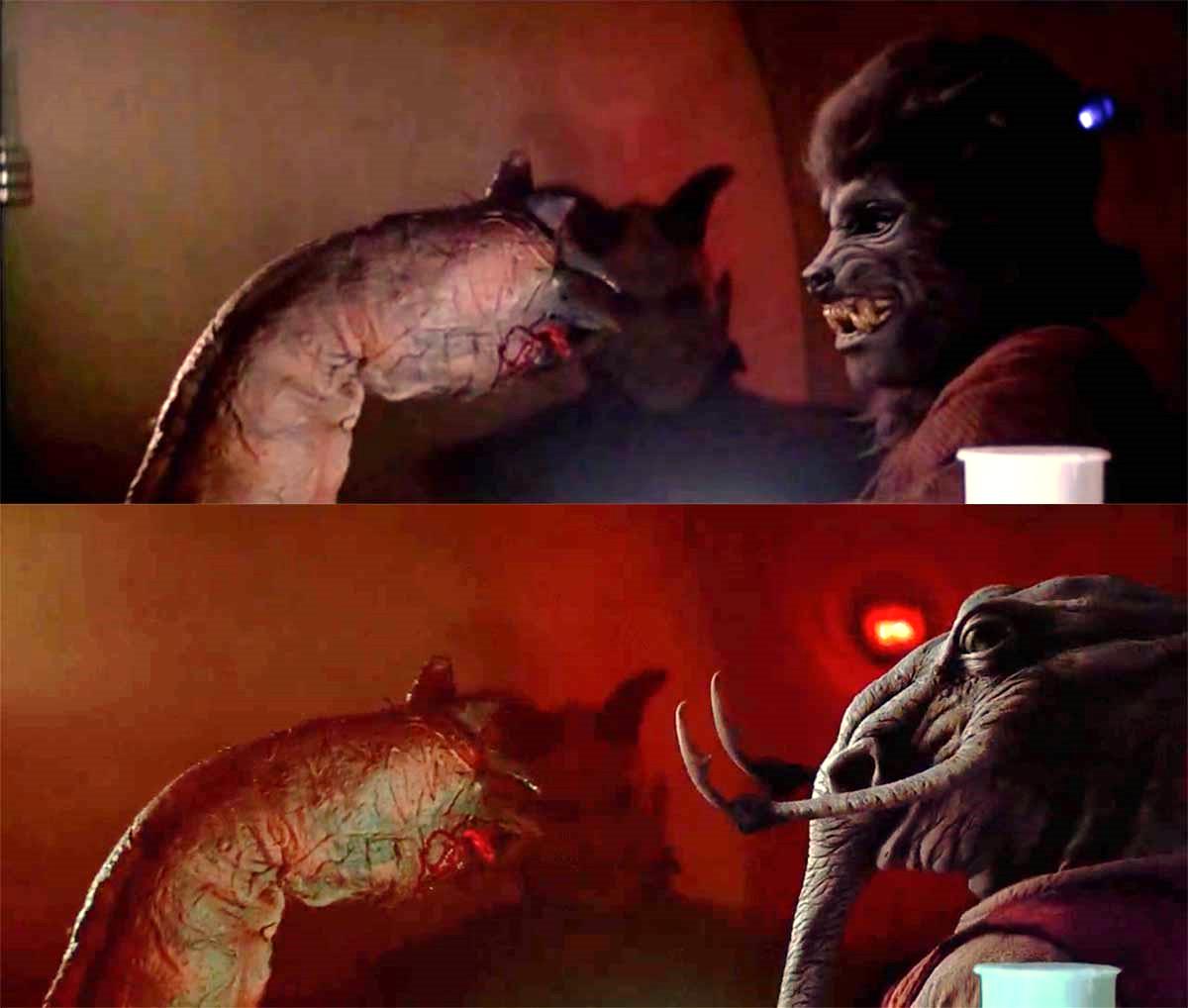
Above: A still frame from the Star Wars: Episode IV: A New Hope theatrical release. Below: A still frame from the same scene in the Blu-ray edition. Courtesy of LucasFilm/Disney.
While the numerous changes to the cantina scene are almost universally derided by Star Wars fans (Han shot first!), the removal of the second werewolf character is the most understandable.
A New Hope was filmed with Lucas himself financing the production. To keep costs down, shortcuts were taken. Props were recycled, which is why decade-old British Royal Air Force flight suits were used in all three Original Trilogy films, including the cantina scene, and the cantina distillery also became the head of the droid bounty hunter IG-88 in Episode V: The Empire Strikes Back![]() . Filling the cantina with aliens was no exception. With only 10 weeks in which to create all the costumes and creatures, not all could be made to order. That’s how a recycled giant human-fly head adorned an extra in the cantina. Thankfully the latter joined Han Solo’s cantina date, Jenny, on the cutting room floor. Other masks were recycled, too, which is how years-old Frankenstein’s monster and werewolf masks from Rick Baker’s vault found their way into the scene. The latter was the red-eyed, tea-sipper at the beginning of the cantina scene. The second wolfman wasn’t even recycled from a prior film; it was an off-the-shelf rubber mask available at any Halloween store of the day.
. Filling the cantina with aliens was no exception. With only 10 weeks in which to create all the costumes and creatures, not all could be made to order. That’s how a recycled giant human-fly head adorned an extra in the cantina. Thankfully the latter joined Han Solo’s cantina date, Jenny, on the cutting room floor. Other masks were recycled, too, which is how years-old Frankenstein’s monster and werewolf masks from Rick Baker’s vault found their way into the scene. The latter was the red-eyed, tea-sipper at the beginning of the cantina scene. The second wolfman wasn’t even recycled from a prior film; it was an off-the-shelf rubber mask available at any Halloween store of the day.
George Lucas reportedly hated both wolfmen. His disdain of the second is understandable; a simple rubber mask, it couldn’t emote or move in any way. Neither did the CGI replacements, which negates Lucas’s alleged gripe with them.
Despite Lucas’s best efforts, the werewolves of Star Wars live on.
To disambiguate, the first werewolf to appear on film, the tea-drinking, red-eyed shadow dweller was referred to on set during film as “Wolfman.” The second, using the off-the-shelf Universal Studios’ The Wolfman mask, came to be called “Hyena-Man.” Both characters received names, species, and backstories in later stories.
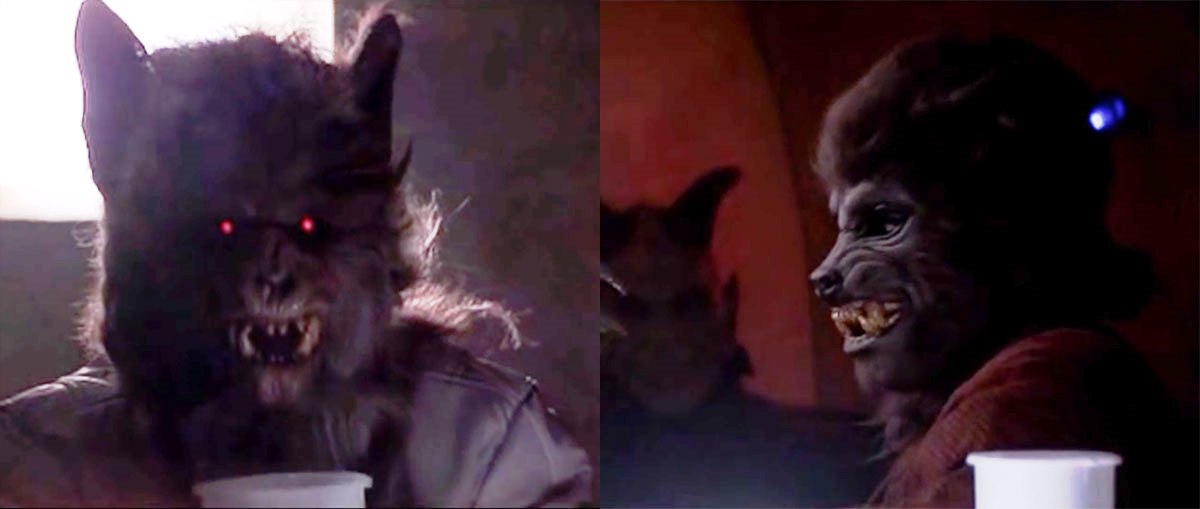
“Wolfman” aka Arleil Schous left; “Hyena-Man” aka Lak Sivrak right. Courtesy of LucasFilm/Disney.
“Wolfman” was identified in the trivia book Star Wars: Absolutely Everything You Need to Know![]() as a Defel named Arleil Schous. Although the Defel species can become virtually invisible by bending light around themselves, by the time we see Schous in A New Hope and later in the Star Wars Holiday Special
as a Defel named Arleil Schous. Although the Defel species can become virtually invisible by bending light around themselves, by the time we see Schous in A New Hope and later in the Star Wars Holiday Special![]() , his advanced age has rendered this ability unreliable. Despite this, he operated in Mos Eisley as a contact for the Rebel Alliance.
, his advanced age has rendered this ability unreliable. Despite this, he operated in Mos Eisley as a contact for the Rebel Alliance.
Schous remains in the Star Wars canon because, despite Lucas’s replacement of him in the tea-sipping shot, he is still visible in the background later in the scene in all editions of A New Hope.
His portrait is the cover of the 1996 Dark Horse comic book Star Wars: Tales From Mos Eisley![]() . Although his portrait being the cover implies a starring role within, the comic features Arleil Schous only as an unnamed supporting character, appearing in only a handful of panels as an Alliance officer enjoying downtime in the cantina.
. Although his portrait being the cover implies a starring role within, the comic features Arleil Schous only as an unnamed supporting character, appearing in only a handful of panels as an Alliance officer enjoying downtime in the cantina.
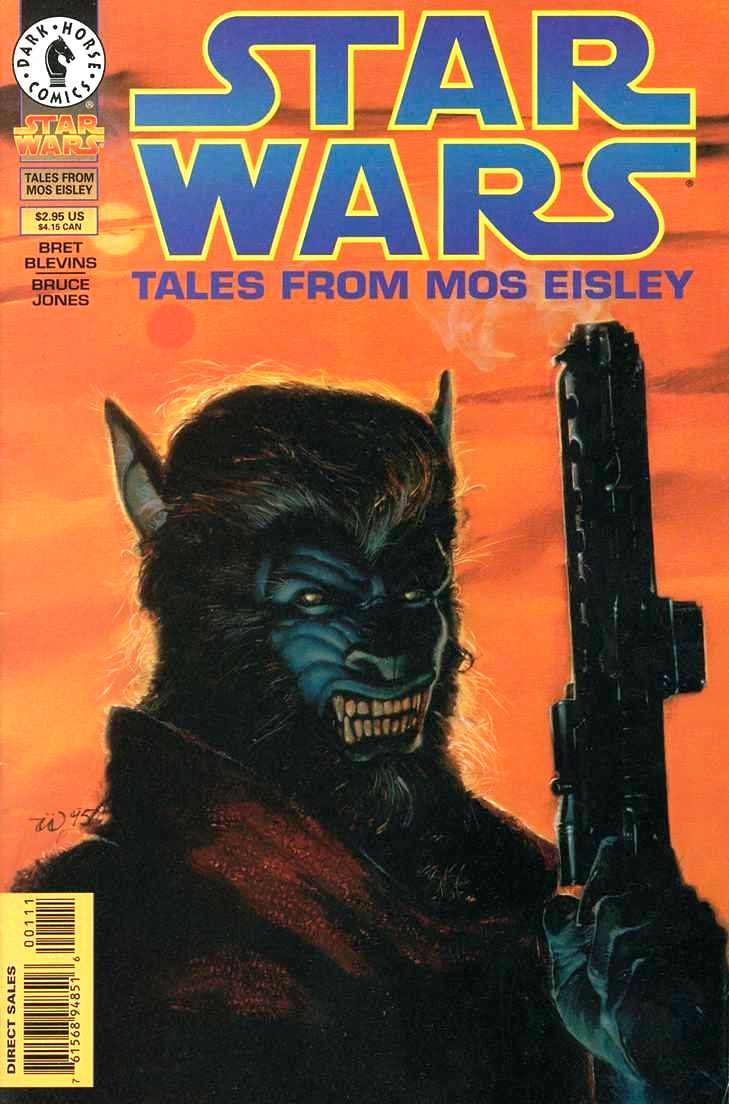
Arleil Schous on the cover of Star Wars: Tales From Mos Eisely. Courtesy of Dark Horse Entertainment.
Slightly longer is the story of the real Wolfman of Star Wars, dubbed “Hyena-Man,” though he is now entirely a Legends character. Despite that, he, unlike Schous, has an official Kenner action figure.
The novel-form short story anthology Tales From the Mos Eisley Cantina![]() provided back stories for many of those in attendance in that fateful day at Chalmun’s Spaceport Cantina when Luke Skywalker and Obi-Wan Kenobi met Han Solo. One such story is “One Last Night in the Mos Eisley Cantina: The Tale of the Wolfman and the Lamproid,” which tells the absurdly non-canon tale of Lak Sivrak, the Shistavanen Wolfman, sharing a Force connection and time-traveling memories with his love, Dice Ibegon, the worm-like Florn Lamproid seen in the theatrical release of A New Hope sharing a table with Sivrak and with the pachydermesque Ketwol in editions since.
provided back stories for many of those in attendance in that fateful day at Chalmun’s Spaceport Cantina when Luke Skywalker and Obi-Wan Kenobi met Han Solo. One such story is “One Last Night in the Mos Eisley Cantina: The Tale of the Wolfman and the Lamproid,” which tells the absurdly non-canon tale of Lak Sivrak, the Shistavanen Wolfman, sharing a Force connection and time-traveling memories with his love, Dice Ibegon, the worm-like Florn Lamproid seen in the theatrical release of A New Hope sharing a table with Sivrak and with the pachydermesque Ketwol in editions since.
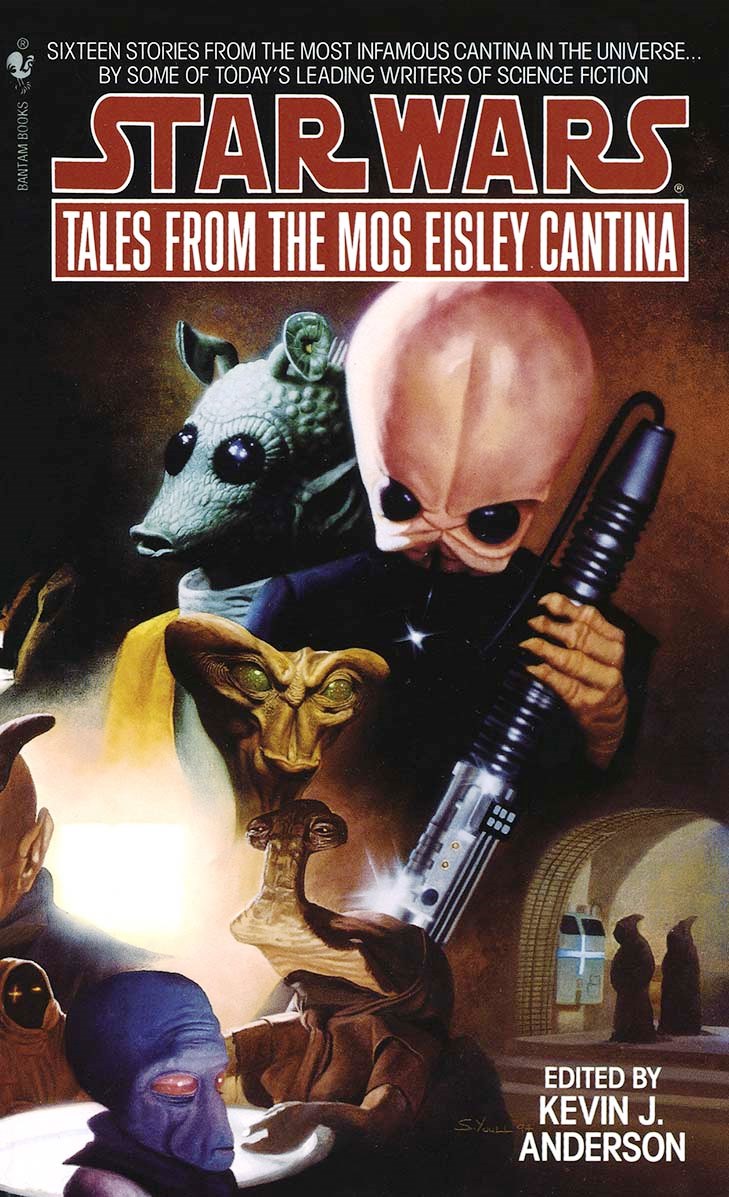
Tales From the Mos Eisley Cantina. Courtesy of Bantam Spectra.
In the story, Sivrak was a Good Samaritan who earned his living as a scout. He took a job scouting for the Empire only to desert when Imperial soldiers tortured Alderaanian refugees in front of him. On the run from the Empire, who wanted to charge him with harboring the fugitive refugees, he found his way to ground in Mos Eisley. There, in the cantina, he met Dice Ibegon.
Eventually Sivrak was recruited into the Rebel Alliance as a scout and later X-Wing pilot. He served the Alliance through an assignment on Hoth, defending and then escaping Echo Base from the Imperial attack depicted in Episode V: The Empire Strikes Back![]() . He perished in battle flying against the Death Star II in the Battle of Endor in Episode VI: Return of the Jedi
. He perished in battle flying against the Death Star II in the Battle of Endor in Episode VI: Return of the Jedi![]() .
.
Tales From the Mos Eisley Cantina was never canon, nor was it Expanded Universe. It is included in Star Wars Legends because all non-canon, non-fan-created stories are lumped together as Star Wars Legends. It is not, however, part of the official continuity of Legends. Despite that, Lak Sivrak was mentioned by name in Michael A Stackpole’s X-Wing: Rogue Squadron![]() , the first novel of the popular, 10-book X-Wing series that was canon via Expanded Universe. That makes Sivrak’s name official Legends continuity.
, the first novel of the popular, 10-book X-Wing series that was canon via Expanded Universe. That makes Sivrak’s name official Legends continuity.
Lak Sivrak, the Wolfman of the Cantina, is allowed a poetic retort in the comic book lampooning of George Lucas’s unnecessary tinkering with the cantina scene. In the story “The Emperor’s Court,” published by Dark Horse Comics’ Star Wars Tales, Volume 1, Number 14![]() , Emperor-turned-Judge Palpatine must preside over the trial of Han Solo for the alleged murder of Greedo. As Star Wars fans know, the greatest of many grievances with Lucas’s alterations to the A New Hope cantina scene is the multiple revisions the encounter between Solo and Greedo, and the latter’s death at the hands of the former. The subject of the trial is indeed those events, with witnesses present in the cantina scene called to recount the event. When Sivrak takes the stand, with Dice Ibegon at his side, Solo objects saying that Sivrak wasn’t even there.
, Emperor-turned-Judge Palpatine must preside over the trial of Han Solo for the alleged murder of Greedo. As Star Wars fans know, the greatest of many grievances with Lucas’s alterations to the A New Hope cantina scene is the multiple revisions the encounter between Solo and Greedo, and the latter’s death at the hands of the former. The subject of the trial is indeed those events, with witnesses present in the cantina scene called to recount the event. When Sivrak takes the stand, with Dice Ibegon at his side, Solo objects saying that Sivrak wasn’t even there.
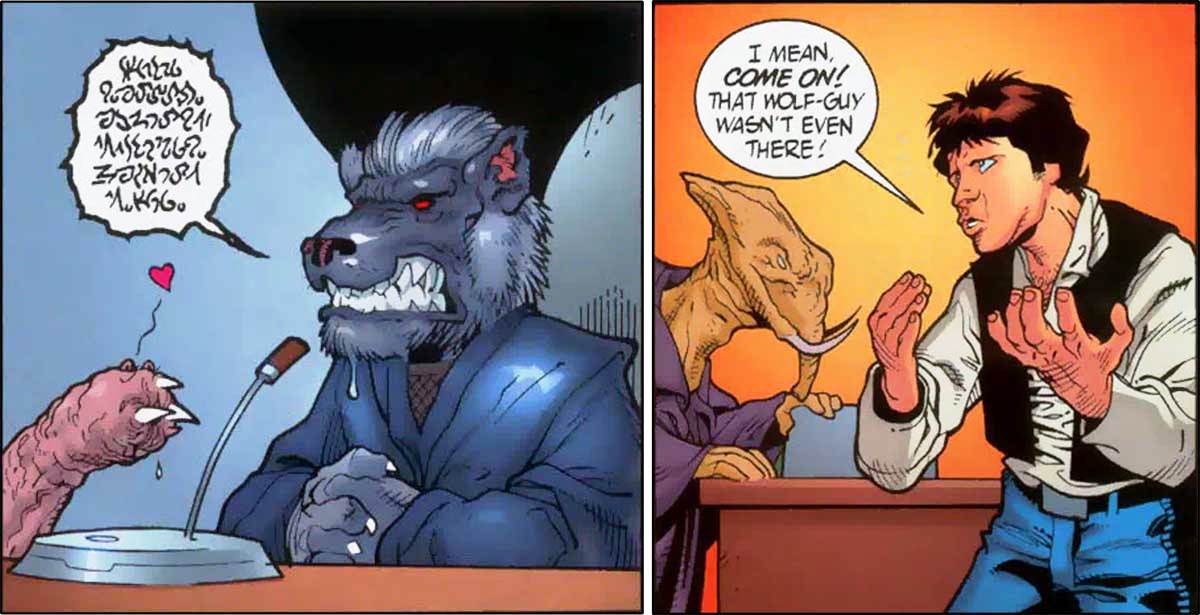
Panels from “The Emperor’s Court.” Courtesy of Dark Horse Entertainment.
In 1998, Kenner released a Lak Sivrak action figure as part of its Star Wars: The Power of the Force toy line![]() . The Power of the Force was created to capitalize on the release of the Special Edition films, the first of which replaced Sivrak, making his inclusion in the toy line an ironic surprise. Moreover, the action figure identified him as Lak Sivrak, though that name was only ever used once in-canon, in X-Wing: Rogue Squadron, and never by the film promoted by the action figures, even in the credits. Most ironic of all, each The Power of the Force action figure was sold with a slide reproducing a still from the film appearance of the character. Thus, Lak Sivrak, whom Lucas erased from the Star Wars films, was sold with a film still of him in the cantina scene in A New Hope!
. The Power of the Force was created to capitalize on the release of the Special Edition films, the first of which replaced Sivrak, making his inclusion in the toy line an ironic surprise. Moreover, the action figure identified him as Lak Sivrak, though that name was only ever used once in-canon, in X-Wing: Rogue Squadron, and never by the film promoted by the action figures, even in the credits. Most ironic of all, each The Power of the Force action figure was sold with a slide reproducing a still from the film appearance of the character. Thus, Lak Sivrak, whom Lucas erased from the Star Wars films, was sold with a film still of him in the cantina scene in A New Hope!
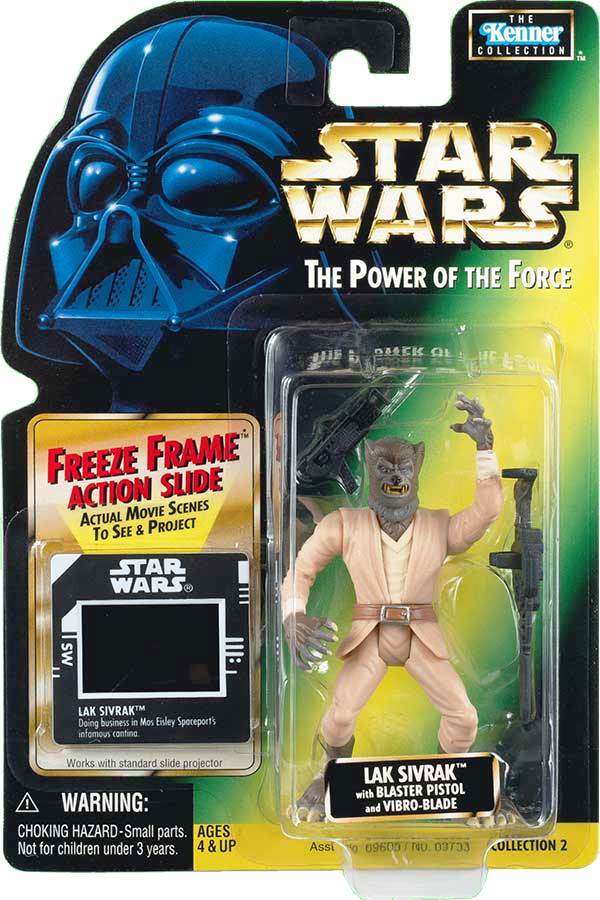
Caption: Lak Sivrak’s The Power of the Force action figure and film still. Courtesy of Kenner.
Lak Sivrak was also restored, via his action figure, to the cantina scene in a 2008 Robot Chicken spoof titled “Wrong Place, Wrong Time![]() .”
.”
You can watch the original theatrical release of the cantina scene with both werewolves of the cantina in 1080p HD on YouTube![]() .
.
What in the Galaxy are those Symbols?
Throughout Who in the Galaxy is That? profiles you may encounter one or more of the following symbols.
Here’s what they mean:
 Canon
Canon- Sources and media cited as canon contain information that is officially part of the Star Wars film universe, which also includes non-film media such as books, comic books, games, and more. This means the information is officially part of the history of Star Wars that appears in the films. It came from, or may appear within or influence, the events of a Star Wars film.
 Legends
Legends- Following Return of the Jedi, George Lucas stated that he would not make other Star Wars movies. He then opened Star Wars to other creators and media. Carefully overseen by Lucas’s company, Lucas Arts, hundreds of new Star Wars novels, comic books and graphic novels, video games, and television shows were created to expand the Star Wars universe and tell stories in all directions—from thousands of years before Luke Skywalker was born to thousands of years after, from filling in the histories of the greatest Star Wars legends to bringing life to every background alien in the Cantina scene. This was the Star Wars Expanded Universe, and it was all canon until new Star Wars films were once again possible. Disney and Lucas Arts then found themselves penned in by the massive amount of material from other creators and projects. They simply couldn’t make Episode VII and beyond because every moment in the lives of the major characters of Han, Luke, Leia, and others had already been chronicled in the Expanded Universe, and very little of that could easily be translated to feature films easily followed by, and appealing to, the many different types of Star Wars fans who loved the Original Trilogy. As a result, a large portion of the formerly-canon Expanded Universe stories were declared non-canon, unofficial in terms of the film continuity. The stories still exist and continue to expand, but now in an alternate reality called Star Wars Legends while other new stories are created alongside them within the universe of the films.
 Fandom-Created
Fandom-Created- Though rare, you’ll see this symbol appear from time-to-time in Who in the Galaxy is That? Star Wars fans are many and varied, and they like to create their own movies, stories, comics, artwork, and more based in the Star Wars universe. Occasionally, a fan-created work is so good and becomes so popular that it gains super star status all on its own. When such rarities relate to the characters profiled in Who in the Galaxy is That?, they are identified by the Fandom-Created symbol.
Suggest a Character to Profile
Have you ever wondered, “who in the galaxy is that?” Tell us in the comments who you’ve wondered about in the Star Wars universe of films, books, comics, games, and even toys. If you know the character’s name, tell us, but if you don’t know a name, tell us where we can find the character that has piqued your curiosity. Something like “the third bounty hunter from the left in the Star Destroyer scene in Empire Strikes Back” works quite well in directing us to who you’re thinking about. Whomever you wonder about, we might just profile in Who in the Galaxy is That?


